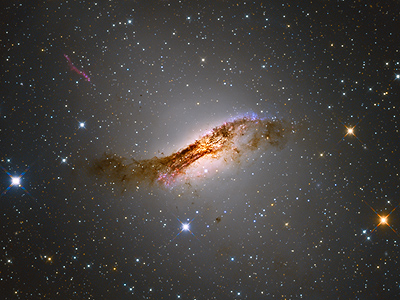|
First, the image, captured by famous group of astro-photographers
Jean Claude Canonne, Nicolas Outters, Philippe Bernhard, Didier
Chaplain and Laurent Bourgon (see their web sites www.cielboreal.com
and www.cielaustral.com), is beautiful astro-photograph,
exceptionally sharp, deep and detailed, showing the silhouette of the
dark interstellar dust lanes on the background of billions of stars
belonging to the Centaurus A galaxy with unprecedented details.

But Centaurus A is interesting also from astrophysical point of
view. This galaxy is a source of intense radio emission (this is how
the designation “Centaurus A” originated – it identifies a source of
radio signals in the constellation Centaurus). Now we know there is a
super-massive black hole in the galaxy center. The black hole attracts
surrounding material, which spirals inward to its event horizon and
creates so-called accretion disk. The matter within accretion disk is
accelerated to insane speeds, reaching significant fractions of the
speed of light. Mutual collisions of such fast-moving matter generate
huge amount of energy, heating material inside the accretion disk. As
the disk itself block the escape path, energy can radiate only through
its poles. Radio images clearly show two jets of material, ejected
from the accretion disk poles, both much longer than the galaxy
itself.
And here comes the second unique quality of this image. In addition
to almost 15 hours of classical LRGB exposures, revealing the galaxy
in real colors, authors added almost 28 hours on narrow-band Hα exposures (shown in deep-red color), which reveal
the hydrogen light of the jet, escaping from the close proximity of
the super-massive black hole.
Image was acquired using the G4-16000 camera on CDK20
telescope.
| 